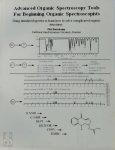Philip Beauchamp - Advanced Organic Spectroscopy Tools for Begi
| Schrijver: | Philip Beauchamp |
|---|---|
| Titel: | Advanced Organic Spectroscopy Tools for Beginning Organic Spectroscopists |
| ISBN: | 9781537473482 |
| Uitgever: | CreateSpace Independent Publishing Platform |
| Bijzonderheden: | Goed, 2016, Paperback, 374p |
| Prijs: | € 17,50 |
| Verzendkosten: | € 4,50 (binnen Nederland) |
| Meer info: |
The goal of this book is to show beginning organic students how to interpret modern organic spectra to solve challenging organic structures, using IR, MS, 1H, 13C, DEPT and several 2D variations of NMR (COSY, HSQC/HETCOR and HMBC). Theory and instrumentation are not emphasized, but are sufficiently explained so that students have a basic idea about how each method works. Simulated spectra are used to remove real-life complexities that make structures too difficult for beginners to solve.It is exciting for beginning students to learn how to correctly generate an organic structure from a hodgepodge of lines and numbers. This book will show how to do that. A very specific plan of attack is presented to approach every problem in a step-by-step fashion, including a one page worksheet to summarize and organize the information to help focus their thinking for every \"What if...'\" question that might arise. Many simple problems are presented to show the mechanical steps of how each method is used to help solve organic structures. More complex problems are designed to be simple enough for beginning students, yet complex enough to require a sustained effort to solve using advanced NMR methods. Real molecules are not used, thereby avoiding the difficulties of overlapping peaks and/or extraneous peaks that should not be there and/or missing peaks that should be there. Students will find a clear path to a correct structure, without encountering real-life frustrations. Most of the common functional group features of organic chemistry are included. Oxygen (alcohols, ethers, esters), nitrogen (amines, amides, nitriles, nitro), halogens and/or sulfur atoms are included at key locations so that chemical shifts are different enough to distinguish each type of proton and carbon in the 1H, 13C, COSY, HETCOR/HSQC and HMBC spectra. This minimizes overlap so that the spectra are easier to interpret for beginning students. It is really the various types of NMR spectra that solve a structure. For the more complex problems, 1H, 13C, DEPT, COSY, HETCOR/HSQC and HMBC are included. An IR chapter is included and a simulated IR is provided in structure problems to provide helpful functional group clues, and details about how alkenes and/or aromatic rings are substituted. In the mass spectrometry chapter, examples of the most common organic monofunctional groups are presented and discussed. However, in complex structure problems, MS is mainly used to provide a molecular weight and indicate the presence of nitrogen, chlorine, bromine and/or sulfur when they are present. These clues can be used to obtain a molecular formula and degrees of unsaturation. Pi bonds can be distinguished from rings using the 13C, which provides a good starting point for solving a structure. Problems range from: shorter structure problems that show how each technique can provide clues to solve a structure; to intermediate level problems that require multiple techniques; to very challenging structure problems that require all of the techniques presented in this book. This workbook will work best for students who are learning basic organic structure determination, and want or need to build on what they are learning to take it to the next level. This can be accomplished in a classroom setting or through self-study by motivated students. If you are an instructor who loves spectroscopy, you might consider trying this approach in one of your course settings to judge for yourself if it works for you and your students. If you are an interested student who can't get enough spectroscopy, just have fun working problems.
|

De verkoper zal binnen 3 werkdagen contact met u opnemen om de koop verder af te handelen.

